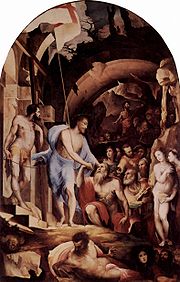
Matthew 27:53
Encyclopedia

Gospel of Matthew
The Gospel According to Matthew is one of the four canonical gospels, one of the three synoptic gospels, and the first book of the New Testament. It tells of the life, ministry, death, and resurrection of Jesus of Nazareth...
in the New Testament
New Testament
The New Testament is the second major division of the Christian biblical canon, the first such division being the much longer Old Testament....
. This verse describes some of the events that occurred upon death of Jesus. The previous verse mentioned that tombs broke open and the saints inside were resurrected. In this verse the saints descend upon the Holy City.
The original Koine Greek
Koine Greek
Koine Greek is the universal dialect of the Greek language spoken throughout post-Classical antiquity , developing from the Attic dialect, with admixture of elements especially from Ionic....
, according to Westcott and Hort
The New Testament in the Original Greek
The New Testament in the Original Greek is the name of a Greek language version of the New Testament published in 1881. It is also known as the Westcott and Hort text, after its editors Brooke Foss Westcott and Fenton John Anthony Hort...
, reads:
- και εξελθοντες εκ των μνημειων μετα την εγερσιν αυτου
- εισηλθον εις την αγιαν πολιν και ενεφανισθησαν πολλοις
In the King James Version of the Bible it is translated as:
- and coming out of the graves after His resurrection,
- they went into the holy city and appeared to many.
The modern World English Bible
World English Bible
The World English Bible is a public domain translation of the Bible that is currently in draft form. Work on the World English Bible began in 1997 and was known as the American Standard Version 1997...
translates the passage as:
- and coming out of the tombs after his resurrection, they
- entered into the holy city and appeared to many.
For a collection of other versions see BibRef Matthew 27:53
These verses see the resurrection of "many" saints, and their appearance in the city where they are seen by "many." The concern that Biblical scholars have had for centuries with this story, is that these momentous events are mentioned nowhere else. Not only are they not noticed by any contemporary non-Christian sources, but none of the other gospel writers mentions this occurring. The author of Matthew gives no further details himself about this event. No reaction to these events is described, nor does he mention what happened to the saints after they appearance. Nolland speculates as to what happened after to the risen saints. He considers it unlikely that they simply returned to the grave after a brief time among the living, he also does not think it likely that the saints resumed their normal lives on Earth. Thus Nolland feels that Matthew probably imagines the saints being translated directly to heaven after a short time on Earth, similar to Elijah.
The text also makes no note on why there is a two day delay between the opening of the tombs upon Jesus' death, and the saints' appearance in the city only after Jesus' resurrection. If these events only happen two days hence, why are they mentioned here and not with the miraculous events of the resurrection at Matthew 28:2
Matthew 28:2
Matthew 28:2 is the second verse of the twenty-eighth chapter of the Gospel of Matthew in the New Testament. This verse is part of the resurrection narrative...
? Some later manuscripts have "after their resurrection" rather than "his," rearranging the timeline. Schweizer speculates that this verse contains an ancient correction to Matthew's original manuscript. Theologically Jesus had to be the first person resurrected, so Schweizer believes the wording of this verse was switched to ensure the saints only rose after Jesus.
Most modern scholars thus do not consider these events to be historical. Bultmann refers to them as "pure novelistic motifs." A Hagnar states the these events make more theological than historical sense. Brown comments that the strength of this part of the narrative is "atmosphere, not details." There have been attempts to reconcile this verse with other sources. One proposition is that by the "holy city" Matthew is not referring to Jerusalem, but rather to heaven
Heaven
Heaven, the Heavens or Seven Heavens, is a common religious cosmological or metaphysical term for the physical or transcendent place from which heavenly beings originate, are enthroned or inhabit...
. The saints thus appeared only in heaven, explaining why no other source makes note of this event. Most scholars reject this understanding, as "holy city" has referred to Jerusalem throughout Matthew's gospel (such as at Matthew 4:5
Matthew 4:5
Matthew 4:5 is the fifth verse of the fourth chapter of the Gospel of Matthew in the New Testament. Jesus has just rebuffed Satan's first temptation in this verse the devil transports him to the site of the second temptation....
). The theory also fails to explain what is meant when Matthew states they were "seen by many."

